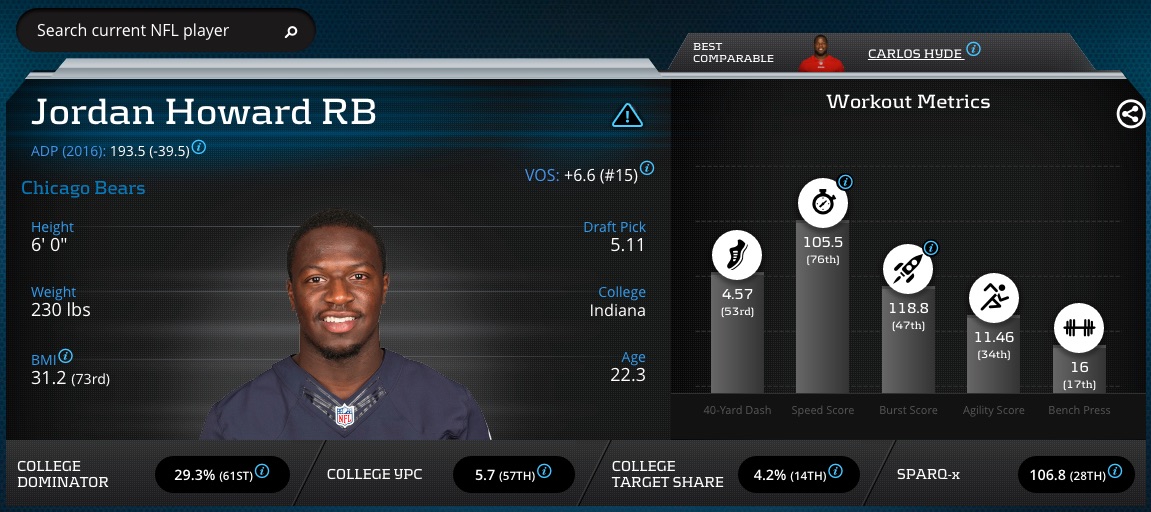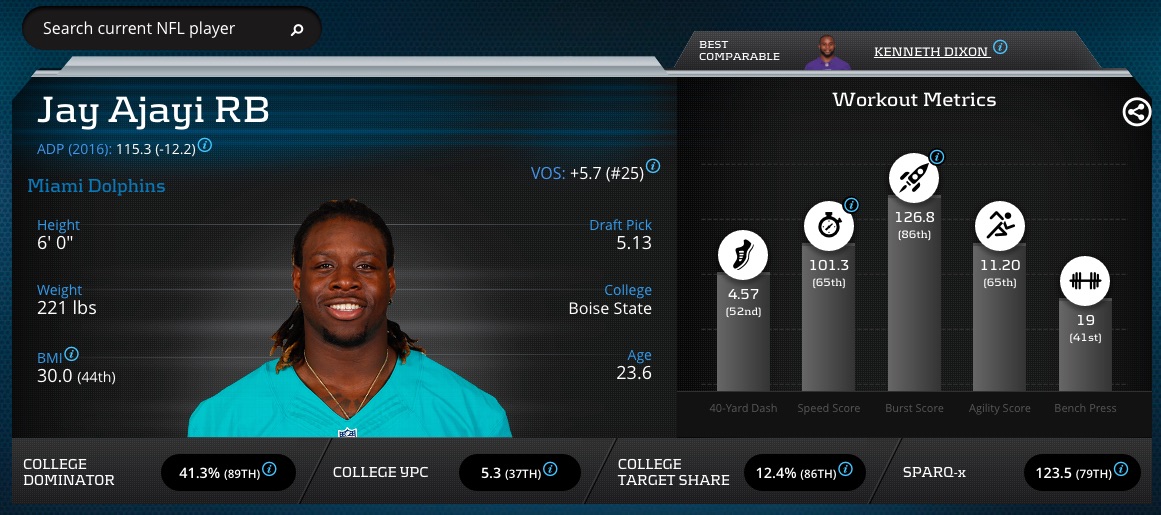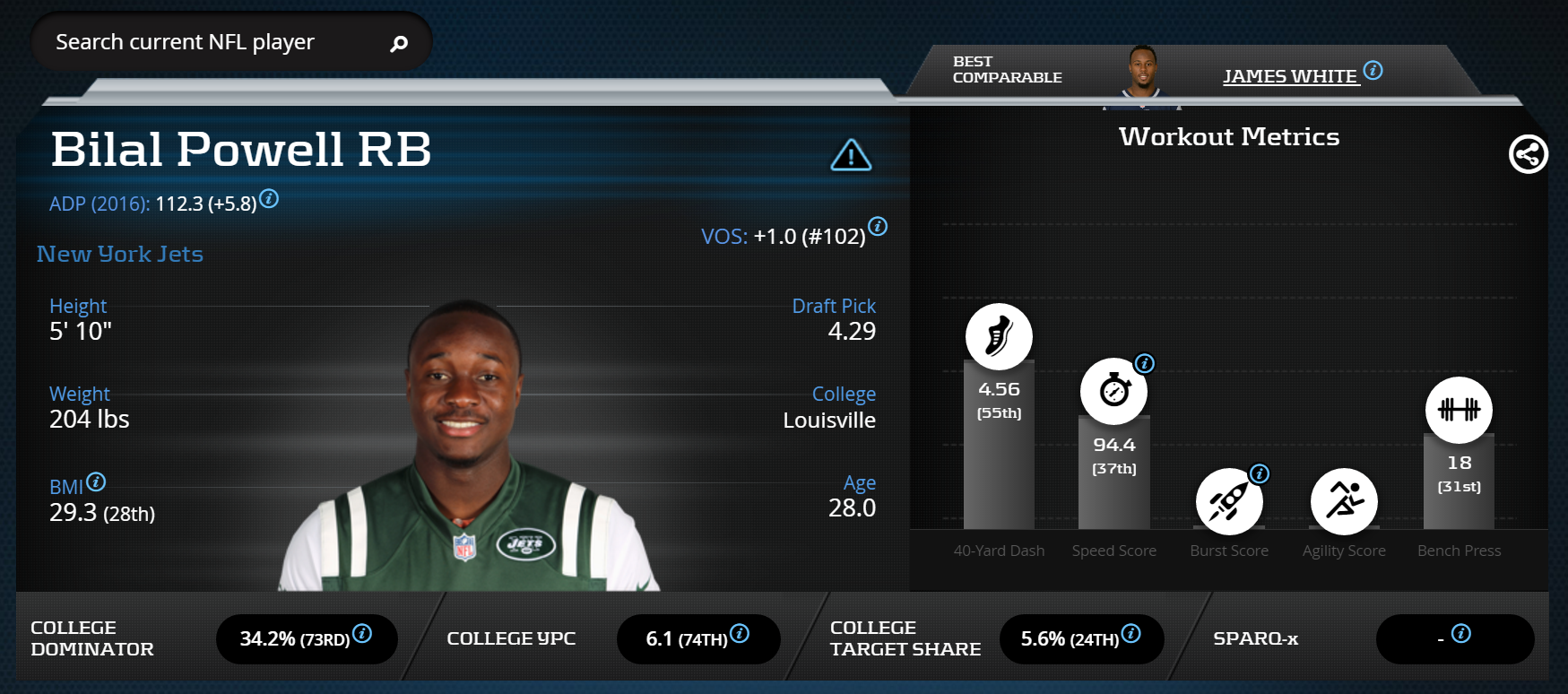While you can’t necessarily win a fantasy league with an early round pick, you can certainly lose one. Here are three running back busts to avoid in the early rounds of redraft leagues, as well as three alternative options to select instead.
High Bust Risk: Jay Ajayi, Miami Dolphins
After Jay Ajayi flashed for mega yardage in several games last season, his ADP shot up into the second round and he’s now regarded as a consensus top 10 running back. Despite the perception, Ajayi’s ability to deliver as a high-end RB1 is doubtful. As the NFL increasingly shifts into a passing league, many modern-day workhorses are expected to not just run the ball, but catch it as well. This pass-catching task would be better handled by Kenyan Drake. With limited opportunities his rookie year, Drake notched a 90-percent catch rate to complement a +24.5 (No. 10) Production Premium. If Drake proves himself as the superior receiving back in camp, the coaching staff will strongly consider implementing a running back-by-committee.
Jay Ajayi will also have to overcome an inadequate offensive line. After Miami’s run blocking unit ranked fifth worst in 2016, they failed to invest high draft capital in a lineman. Miami’s failure to upgrade the line means we should expect this obstacle to persist for Ajayi. Ajayi also will face plenty of tough run defenses next season after drawing the fourth toughest schedule among fantasy running backs, according to FantasyPros. The red flags stack up too high against Ajayi. Let’s be honest, he looks like the centerpiece of the last place team in your league next year.
Alternative: Isaiah Crowell, Cleveland Browns
If you’re seeking a cheaper option than Jay Ajayi, look no further. Isaiah Crowell finds himself in a similar position as Ajayi, but you can get him several rounds cheaper. Not only did Crowell achieve fantasy RB2 status last year (No. 20 in fantasy points per game), but he also displayed tremendous big play ability, posting a 6.6-percent (No. 13) Breakaway Run Rate. In the offseason, the Browns signed free agent center J.C. Tretter and guard Kevin Zeitler, both of whom should open up more running lanes for Crowell in the future. Expect Crowell’s big plays to uptick even more next year behind a remodeled offensive line.
https://www.youtube.com/watch?v=fEufa8KGH0Y
Not only did Cleveland provide blocking support for Crowell, but also secured his volume in the offseason. Any questions surrounding Isaiah Crowell‘s job security were quickly wiped away when Cleveland elected to pass on a running back until the final round of the NFL Draft. We now have a clearer picture of the Browns’ backfield where Crowell will receive the favorable portion of the timeshare, splitting with efficient satellite back Duke Johnson.
High Bust Risk: Jordan Howard, Chicago Bears
After yanking the starting job from Jeremy Langford‘s hands and racking up 1314 (No. 2) rushing yards as a rookie, Jordan Howard predictably gets the first round price tag for 2017. While Howard will benefit from his run blocking offensive line (ranked No. 5), his volume will diminish if Langford reclaims a role in the passing game. Langford was a more productive pass catcher than Howard with a superior catch rate in 2016. Langford also compiled 19 receptions with just a fraction of the playing time. Howard, on the other hand, failed to reach 30 receptions with the lion’s share of opportunity. Chicago’s game script will also damage Howard’s volume in 2017, as it will force them to throw the ball more than they desire.

Alternative: DeMarco Murray, Tennessee Titans
If you pivot away from Jordan Howard near the end of the first round, choose DeMarco Murray instead and you’ll never look back. He has everything you look for in a fantasy running back: he can sustain a 3-down role, he’s supported by a top 10 offensive line, and he’s paired with Marcus Mariota, who will keep defenses from stacking the box. Murray, unlike Howard, is also a major contributor to Tennessee’s aerial attack and therefore isn’t game script dependent. Accumulating 53 (No. 6 among NFL running backs) receptions in 2016, Murray proved he can produce fantasy points regardless of the score.
https://www.youtube.com/watch?v=NDKH4t4Vzic&t=60s
High Bust Risk: Leonard Fournette, Jacksonville Jaguars
Is Leonard Fournette a generational talent? No. Is he the next Adrian Peterson? Doubt it. Will he break out in fantasy this year? Absolutely not. I am convinced Fournette is the next Todd Gurley in fantasy, which isn’t a compliment. The two seem to be on eerily similar career paths. Both SEC running backs were selected to teams with equally unfriendly fantasy environments. Gurley is faced with a grossly incompetent quarterback, Jared Goff, to go along with an offensive line ranked No. 24 last season. Fournette heads into Jacksonville, home to a run blocking offensive line ranked No. 25 in 2016, and a quarterback Blake Bortles who is arguably the worst starter in the NFL.
https://www.youtube.com/watch?v=VouGn4AcDKc
Additionally, Leonard Fournette only mustered 41 total receptions throughout his three-year career at LSU. Fournette’s lack of receiving production raised questions regarding his receiving abilities at the pro level, and it is unclear whether he’ll garner enough targets from Blake Bortles to be a viable PPR back.
Alternative: Bilal Powell, New York Jets
Although Bilal Powell has been the Jets’ supreme running back for quite some time, his ADP is outrageously low. The Jets did not select a running back until Elijah McGuire in the sixth round to fill out the depth chart. The coaching staff seems confident with their backfield moving forward with Powell at the helm, as they should be.
Powell was exceptionally efficient last season, finishing among the top 15 in Breakaway Run Rate, Juke Rate, and yards per touch. Powell was also a prolific receiver in 2016 with 58 (No. 4) receptions and 384 (No. 10) receiving yards. Behind an offensive line ranked No. 6 last season, Powell’s situation finally allows him to establish himself as a fantasy RB1 if he’s given the workload.










